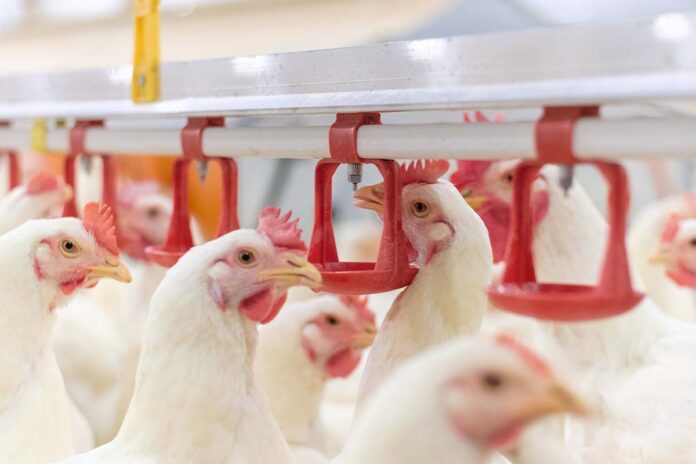
USPOULTRY and the USPOULTRY Foundation announced the completion of a funded research project at the University of Georgia in Athens, Georgia, in which researchers examined the benefits of nipple drinker catch trays.
Project #F085: Evaluation of a drinker system with or without trays on house litter conditions, bird performance, health and welfare – Michael Czarick, Department of Poultry Science, University of Georgia, Athens, Georgia.
Michael Czarick and colleagues at the University of Georgia Department of Poultry Science have recently completed a research project with the objective of evaluating the effect of catch trays on broiler water usage, litter moisture, water activity, footpad health and whether catch trays increase a bird’s exposure to Salmonella and/or Pseudomonas. Overall, the study indicated that catch trays did not affect bird water usage and may help maintain lower moisture and water activity in the litter underneath drinker lines. This data suggests that catch trays do not contribute to Salmonella growth.
High litter moisture or “wet litter” has been associated with footpad lesion development, breast blisters, hock burns, increased ammonia production and higher microbial activity. Proper litter moisture can be sustained, to a large extent, by adjusting minimum ventilation rates to maintain an environmental relative humidity of 50% or lower. However, maintaining that level of relative humidity may not be economically feasible due to the higher heating costs associated with the relatively high minimum ventilation rates required to maintain a relative humidity of 50% or lower.
Even when drinker lines are managed according to manufacturer guidelines, maintaining proper litter conditions near the drinker lines has traditionally proven to be a challenge for poultry producers. It is a fine balancing act of making it easy for the birds to quickly consume the water they need and minimizing wastage so litter moisture can be kept to a minimum. To maximize bird performance, producers often err on the side of easy access (i.e., lower drinker lines, higher flow rate nipples, higher drinker line pressures, etc.) resulting in increased water wastage and in turn excessive litter moisture under the drinker lines.
One possible method of reducing the potential for wasted water contributing to litter moisture is through the use of nipple drinker catch trays. The use of catch trays on drinker lines is somewhat limited in the U.S. Though many operations with drinker catch trays have reported drier litter underneath drinker lines, little research has been published on their impact on litter moisture.
The objective of this study was to evaluate the effect of catch trays on broiler water usage, litter moisture, water activity, footpad health and whether catch trays increase a bird’s exposure to Salmonella and / or Pseudomonas.
The study was conducted on a three-house commercial broiler farm. Each house was subdivided into four sections for a total of 12 sections. Five sections had drinker lines with catch trays, and five had identical drinker lines without catch trays. Two sections had two drinker lines with trays and two without.
In all four flocks studied, there were no significant differences in broiler water usage between a drinker system without catch trays versus with catch trays. The data showed birds had no preference in drinker systems with or without catch trays. The catch tray systems had significantly lower litter moisture and water activity from day 7 to the last sampling day in all four flocks. In addition, in three out of four flocks, the catch tray systems litter moisture was below 25%. In three out of four flocks, during the first 21 days, the catch tray systems and non-catch tray systems had no footpad lesions. Yet, in flock 4, the catch tray and non-catch tray systems had minor occurrences of footpad lesions (<8%). In all four flocks at day 28 and the last sampling day, the non-catch tray systems had numerically more footpad lesions than the catch tray systems. However, the difference was less than 15%.
Prior to the study, all test houses had litter tested for Salmonella and all houses came back positive. Yet, when catch trays were tested for presence of Salmonella, all tests came back negative for all four flocks. This data suggests that catch trays do not contribute to Salmonella growth. Overall, the study indicate that catch trays did not affect bird water usage and may help maintain lower moisture and water activity in the litter underneath drinker lines.
The research was made possible in part by an endowing Foundation gift from Claxton Poultry and is part of the Association’s comprehensive research program encompassing all phases of poultry and egg production and processing. A complete report, along with information on other Association research, may be obtained through USPOULTRY’s website, www.uspoultry.org.

















